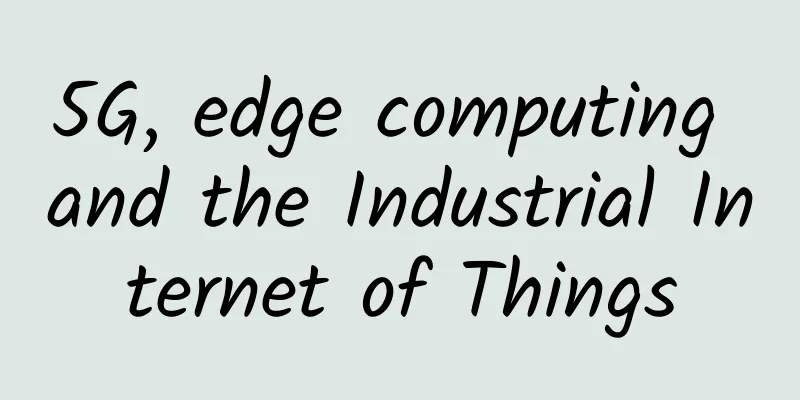5G, edge computing and the Industrial Internet of Things

|
The new 5G network will transform many industries in the coming years. From factory floors to healthcare, financial services and even entertainment, industries will enter a new stage of connectivity as 5G network technology is gradually implemented. In addition to significantly increasing speed and throughput, 5G networks can also leverage network virtualization to provide "network slicing" for the unique needs of the IIoT (Industrial Internet of Things). While this will transform many industries, the manufacturing industry can benefit greatly from higher bandwidth, lower latency, and more reliable wireless networks! 5G: Transforming the factory Currently, most factories are connected via wired connections with traditional fieldbuses or Industrial Ethernet, which act as the backbone connecting field-level devices to control systems and PLCs. New standards such as OPC-UA allow factories to be connected to the enterprise by providing a structured and secure way to access and control data. The second phase of the 5G specification (3GPP Release 16) targets factory automation with ultra-reliable, low-latency communications (uRLLC), enhanced massive machine type communications (eMTC), and enhanced mobile broadband (eMBB). The most significant enhancements are in latency and reliability, aimed at enabling mission-critical applications in industrial environments. 5G networks can provide critical capabilities on the factory floor in terms of low latency, high reliability and support for a large number of devices. In addition, 5G-enabled devices can "offload" some of their processing to the network, making the equipment simpler and cheaper. The impact of 5G “network edge” on IIoT The Industrial Internet of Things (IIoT) requires multiple complementary technologies to achieve improvements in automation, efficiency, and agility. It requires dashboards, device communications and management capabilities for managing a variety of device types, real-time streaming for actionable intelligence, machine learning capabilities to recognize patterns and predict behavior, and AR to enhance manual guidance and training. 5G has low latency, high security, and customized networks that enable factories to take full advantage of sensors and IoT for asset monitoring and automation as well as artificial intelligence and machine learning capabilities. Many of these will happen locally, but also increasingly in the cloud. IIoT platforms that can integrate with cloud hyperscale (such as Amazon AWS and Microsoft Azure) will be a key enabler of the 5G-enabled IIoT ecosystem. To support latency-sensitive applications at the edge of 5G networks, Amazon and Verizon jointly announced the launch of AWS "Wavelength Zones". By embedding a portion of AWS infrastructure into Verizon's data centers, the journey from devices to the AWS cloud can be shortened. Microsoft also leveraged its past partnership with AT&T and recently launched Azure Edge Zones. In addition, Microsoft's recent acquisition of Affirmed Networks aims to bring cloud-based 5G networks to market. As 5G specifications mature, the “network edge” can become a hotspot for innovation among hyperscalers, operators, and IIoT platform providers to enable latency-sensitive IIoT applications for industrial automation. |
<<: Understanding TCP/IP protocol stack HTTP2.0
>>: The speed can reach 10,000 times that of 5G, and the official interpretation of 6G is here
Recommend
HostYun UK London AS9929 line VPS host 10% discount monthly payment starting from 22.5 yuan, native IP
Those who are interested in UK VPS can pay attent...
The Winter Olympics is about to open, and the on-site communication network technology is deeply revealed!
In 11 days, the world-renowned Beijing Winter Oly...
MoeCloud Canada VPS annual payment starts from 99 yuan, San Jose/London CN2 GIA line annual payment starts from 499 yuan
MoeCloud is a foreign VPS hosting service provide...
What does Wi-Fi bring to Matter’s push for home IoT?
As Matter’s foundational technology, Wi-Fi can he...
5G and edge computing are a perfect match
Enterprise IT leaders have heard a lot about edge...
5G is here, will the next golden age belong to the Internet of Things?
On December 4, 2013, the Ministry of Industry and...
Introduction and solution of TCP sticky packet and half packet (Part 1)
In network transmission, sticky packets and half ...
Migu Video’s Wang Bin: The growth of the pan-entertainment industry in the 5G era
[51CTO.com original article] From July 11 to 13, ...
The Internet of Things is gradually entering a new era. These will affect our lives in the future.
Today, the rapidly developing IoT devices can rea...
The mobile phone business was hit hard in 2020: Even the 5G boost could not save sales
Even though 5G has been gradually deployed to mai...
Who is responsible for the rampant online black industry?
[[188973]] A set of data: According to the 38th &...
Wind River Alex Wilson: Integrated modularity is the development direction of avionics systems
[51CTO.com original article] At the just conclude...
TmhHost back-to-school season discount: Los Angeles, Japan, South Korea CN2 line VPS quarterly payment starting from 100 yuan
TmhHost's back-to-school season event is stil...
CC attack & TCP and UDP correct opening posture
introduction: 1: CC attack is normal business log...
Laying the foundation for digital finance | H3C launches S12500G-EF, a new generation of green smart switches
On April 25, New H3C Group, a subsidiary of Tsing...









